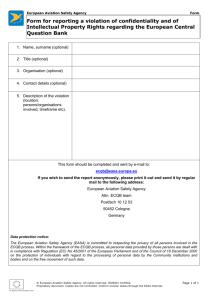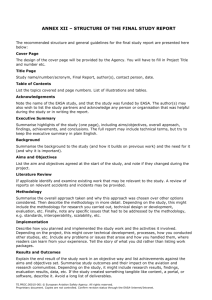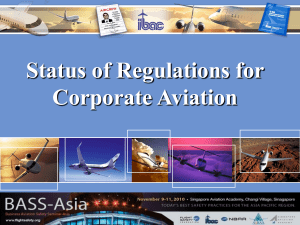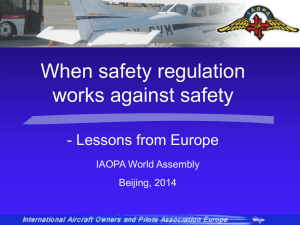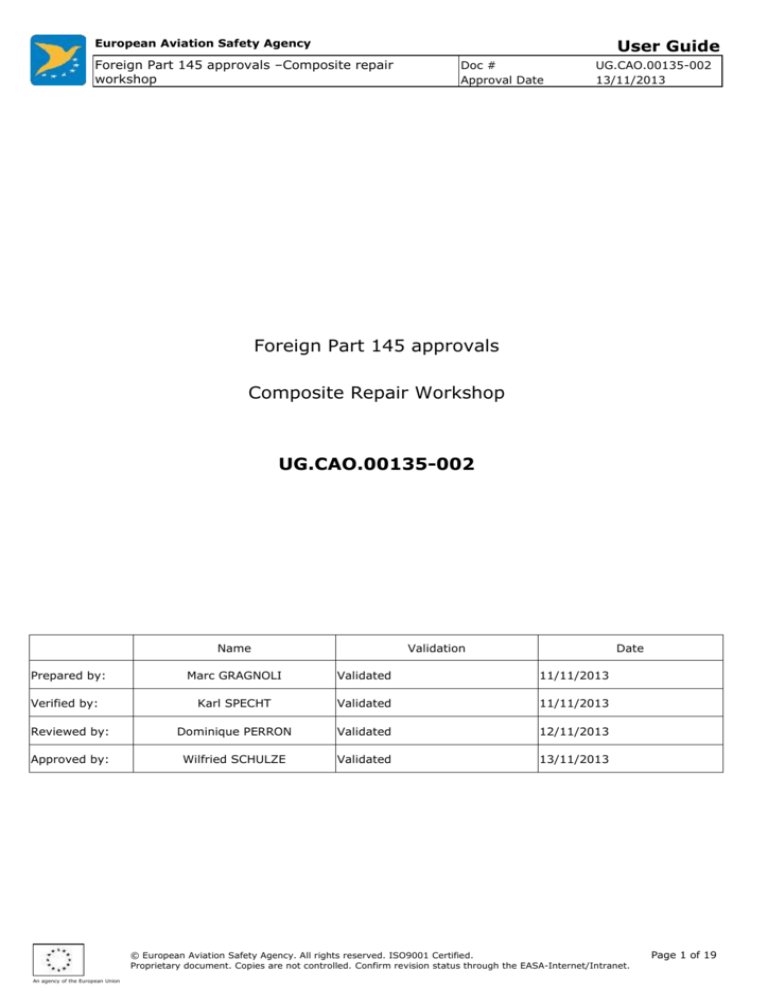
User Guide
European Aviation Safety Agency
Foreign Part 145 approvals –Composite repair
workshop
Doc #
Approval Date
UG.CAO.00135-002
13/11/2013
Foreign Part 145 approvals
Composite Repair Workshop
UG.CAO.00135-002
Name
Validation
Date
Marc GRAGNOLI
Validated
11/11/2013
Karl SPECHT
Validated
11/11/2013
Reviewed by:
Dominique PERRON
Validated
12/11/2013
Approved by:
Wilfried SCHULZE
Validated
13/11/2013
Prepared by:
Verified by:
© European Aviation Safety Agency. All rights reserved. ISO9001 Certified.
Proprietary document. Copies are not controlled. Confirm revision status through the EASA-Internet/Intranet.
An agency of the European Union
Page 1 of 19
User Guide
European Aviation Safety Agency
Foreign Part 145 approvals –Composite repair
workshop
Doc #
Approval Date
UG.CAO.00135-002
13/11/2013
DOCUMENT CONTROL SHEET
Reference documents
a) Contextual documents
Commission Regulation (EC) 2042/2003 - Commission Regulation (EC) of 20 November 2003 laying down
implementing rules for the continuing airworthiness of aircraft and aeronautical products, parts and appliances, and
on the approval of organisations and personnel involved in these tasks
Commission Regulation (EC) 593/2007 - Regulation of 31 May 2007 on the fees and charges levied by the European
Aviation Safety Agency Regulation (OJ L140, 01.06.2007)
EASA/FAA Maintenance Annex Guidance (MAG)
EASA/TCCA Maintenance Annex Guidance ( MAG)
ED Decision 2003/19/RM - On AMC and GM to Commission Regulation (EC) 2042/2003 of 20 November 2003 on the
continuing airworthiness of aircraft and aeronautical products, parts and appliances, and on the approval of
organisations and personnel involved in these tasks
MB decision 01-2011 - On guidelines for allocation of certification tasks to national aviation authorities and qualified
entities.
Regulation (EC) 216/2008 - Regulation of European Parliament and of Council of 20 Feb. 2008 on common rules in
the field of civil aviation and establishing a European Aviation Safety Agency and repealing Council Directive
91/670/EEC, Regulation (EC)1592/2002 and Directive 2004/36/EC
b) Internal documents
Applicable document are listed in the form “FO.CAO.00136-XXX - Foreign Part 145 approvals – Documentation
Index”.
Log of issues
Issue
Issue date
Change description
001
13/11/2013
First issue. This document is aimed to provide the applicant with guidance
material supporting the application/approval, and as such has been
reviewed by Rulemaking Product Support Continuing Airworthiness Section
(R.4.2).
002
01/09/2014
Update of Quality documents to implement the new corporate image of the
Agency and the changes to the organization structure.
© European Aviation Safety Agency. All rights reserved. ISO9001 Certified.
Proprietary document. Copies are not controlled. Confirm revision status through the EASA-Internet/Intranet.
An agency of the European Union
Page 2 of 19
User Guide
European Aviation Safety Agency
Foreign Part 145 approvals –Composite repair
workshop
0.
Doc #
Approval Date
UG.CAO.00135-002
13/11/2013
Introduction.
© European Aviation Safety Agency. All rights reserved. ISO9001 Certified.
Proprietary document. Copies are not controlled. Confirm revision status through the EASA-Internet/Intranet.
An agency of the European Union
Page 3 of 19
User Guide
European Aviation Safety Agency
Foreign Part 145 approvals –Composite repair
workshop
Doc #
Approval Date
UG.CAO.00135-002
13/11/2013
0.1. Table of Contents.
0.
1.
2
3
4
5
Introduction. ...................................................................................................................................... 3
0.1. Table of Contents. ........................................................................................................................ 4
0.2. Definitions and Abbreviations. ...................................................................................................... 5
0.3. Scope and Applicability. ............................................................................................................... 6
0.4. Purpose........................................................................................................................................ 6
0.5. Associated Instructions................................................................................................................. 6
0.6. Communication. ........................................................................................................................... 6
EASA Part 145 Regulation Overview. ................................................................................................ 7
1.1 Maintenance and/or Manufacturer. ............................................................................................... 8
1.2 Part 145 Approval (Ratings Required). ......................................................................................... 8
Composite Structure Repair. ............................................................................................................. 9
2.1 Basic Families of Composite Structure. ...................................................................................... 10
2.2 Basic Types of Composite Repairs. ............................................................................................ 10
General Requirements. ................................................................................................................... 11
3.1 Approved Data. ........................................................................................................................... 12
3.2 Maintenance Records. ................................................................................................................ 12
3.3 Training for Composite Technicians. ........................................................................................... 12
3.4 Safety Precautions. ..................................................................................................................... 13
Peculiarities of MROs Facilities and Processes ............................................................................... 14
4.1 Facilities and Processes. ............................................................................................................ 15
4.2 Incoming Inspection of Raw Material. ......................................................................................... 15
4.3 Material Handling and Storage. ................................................................................................... 15
4.3.1 Shelf life and Temperature Considerations. ............................................................................ 15
4.3.2 Storage and Handling Recommendations. .............................................................................. 15
4.3.3 Unserviceable Aircraft Components Incoming Area. ............................................................... 15
4.4 Composite Bonded Repair Workshop. ........................................................................................ 16
4.5 Tools and Equipment. ................................................................................................................. 17
Samples of Repairs. ........................................................................................................................ 18
5.1 Bolted Repairs. ........................................................................................................................... 19
5.2 Bonded Repairs. ......................................................................................................................... 19
© European Aviation Safety Agency. All rights reserved. ISO9001 Certified.
Proprietary document. Copies are not controlled. Confirm revision status through the EASA-Internet/Intranet.
An agency of the European Union
Page 4 of 19
User Guide
European Aviation Safety Agency
Foreign Part 145 approvals –Composite repair
workshop
Doc #
Approval Date
UG.CAO.00135-002
13/11/2013
0.2. Definitions and Abbreviations.
Abbreviations
A&P
AMC
AMO
CAA
CAMO
CAMOC
CAN145
CAOM
CAO
CAP
C/S
CC/S
EASA
EU
F145
F147
FAA
GM
IORS
MOA
MOAP
MOC
MOE
MOR
MTOA
MTOAP
MTOC
MTOE
NAA
PPB
QE
SIS
TCCA
US145
WG
WH
WHOC
APPLICATIONS AND PROCUREMENTS SERVICES
ACCEPTABLE MEANS OF COMPLIANCE
APPROVED MAINTENANCE ORGANISATION
CIVIL AVIATION AUTHORITY
CONTINUING AIRWORTHINESS MANAGEMENT ORGANISATION
CONTINUING AIRWORTHINESS MANAGEMENT OVERSIGHT COORDINATOR
CANADIAN PART 145
CONTINUING AIRWORTHINESS ORGANISATIONS MANAGER
CONTINUING AIRWORTHINESS ORGANISATION
CORRECTIVE ACTION PLAN
CERTIFYING STAFF
COMPONENT CERTIFYING STAFF
EUROPEAN AVIATION SAFETY AGENCY
EUROPEAN UNION
FOREIGN PART 145
FOREIGN PART 147
FEDERAL AVIATION ADMINISTRATION
EASA GUIDANCE MATERIAL
INTERNAL OCCURENCE REPROTING SYSTEM
MAINTENANCE ORGANISATION APPROVAL
MAINTENANCE ORGANISATION APPROVAL PROCEDURES
MAINTENANCE OVERSIGHT COORDINATOR
MAINTENANCE ORGANISATION EXPOSITION
MANDATORY OCCURRENCE REPORTING
MAINTENANCE TRAINING ORGANISATION APPROVAL
MAINTENANCE TRAINING ORGANISATION APPROVAL PROCEDURES
MAINTENANCE TRAINING OVERSIGHT COORDINATOR
MAINTENANCE TRAINING ORGANISATION EXPOSITION
NATIONAL AIRWORTHINESS AUTHORITY
PRINCIPAL PLACE OF BUSINESS
QUALIFIED ENTITY
SAMPLING INSPECTION SYSTEM
TRANSPORT CANADA CIVIL AVIATION
US PART 145
WORKING GROUP
WORKING HOURS
WORKING HOURS EASA OVERSIGHT COORDINATOR
© European Aviation Safety Agency. All rights reserved. ISO9001 Certified.
Proprietary document. Copies are not controlled. Confirm revision status through the EASA-Internet/Intranet.
An agency of the European Union
Page 5 of 19
User Guide
European Aviation Safety Agency
Foreign Part 145 approvals –Composite repair
workshop
Doc #
Approval Date
UG.CAO.00135-002
13/11/2013
0.3. Scope and Applicability.
This user guide is applicable to EASA Part 145 organisations having their principal place
of business located outside the EU Member States, the USA and Canada (hereinafter
referred to as “Foreign Part 145 organisations”).
EASA is the Competent Authority for the maintenance organisations as established by
Part 145.1 “General” and therefore responsible for the final approval of those
Organisations. EASA has also established procedures detailing how EASA Part 145
application and approval are managed.
This user guide is complementary to the requirements of Implementing Rule - Regulation
EU 2042/2003 Annex II, Part-145 “as amended” and does not supersede or replace the
information defined within that document.
This User Guide come into effect 90 days after publication on the EASA website
0.4. Purpose.
This user guide is issued to provide a guidance to EASA Part 145 Organisations to identify
key elements, to be considered as minimum requirements to comply with the Part 145
regulation, when dealing with repairs on composite aircraft structure with particular
reference to the development of a composite repair workshop for bonded repairs.
It is not the intent of this document to provide instructions on the repair techniques
and/or to supersede the regulation requirements and/or the relevant maintenance data.
This user guide is aimed to be used by both EASA Part 145 Maintenance organisations
and Assigned inspector.
0.5. Associated Instructions.
EASA has developed associated instructions (user guides, Forms, templates and work
instructions), that detail specific matters, which have to be considered as an integral part
of this procedure.
A complete listing of these documents, together with their applicability to the applicant/
approval holder or NAA / QE / EASA, is addressed in the current revision of the “Foreign
Part 145 approvals – documentation Index”, FO.CAO.00136-XXX (XXX identifies
the revision number). Documents which are applicable to both NAA/QE/EASA and
Applicant /Approval holder are made available on the EASA Web site:
http://easa.europa.eu/approvals-and-standardisation/organisation-approvals/CAO-related-toregulation-2042-2003-part-145.php.
Each time a cross reference is provided to another document or another chapter /
paragraph of the same document, this reference is identified with grey text.
0.6. Communication.
All documents and correspondences between the Applicant, the overseeing authority and
EASA shall be in the English language unless otherwise agreed by EASA.
© European Aviation Safety Agency. All rights reserved. ISO9001 Certified.
Proprietary document. Copies are not controlled. Confirm revision status through the EASA-Internet/Intranet.
An agency of the European Union
Page 6 of 19
User Guide
European Aviation Safety Agency
Foreign Part 145 approvals –Composite repair
workshop
1.
Doc #
Approval Date
UG.CAO.00135-002
13/11/2013
EASA Part 145 Regulation Overview.
© European Aviation Safety Agency. All rights reserved. ISO9001 Certified.
Proprietary document. Copies are not controlled. Confirm revision status through the EASA-Internet/Intranet.
An agency of the European Union
Page 7 of 19
User Guide
European Aviation Safety Agency
Foreign Part 145 approvals –Composite repair
workshop
Doc #
Approval Date
UG.CAO.00135-002
13/11/2013
Maintenance and/or Manufacturer.
Composites aircraft structure activities in a Part 145 AMO may be considered in terms of
maintenance (e.g., repair, overhaul, etc.) and/or in terms of parts fabrication (normally
limited to “Fabrication of secondary structural elements”). In particular, requirements for
the fabrication of parts under the scope of a Part-145 approval is given in 145.A.42.(c)
and related AMC.
Part 145 Approval (Ratings Required).
The activities described in chapter 1.1 may be performed under an Ax rating (Line or
Base aircraft maintenance scope of work) or under Cx rating (components maintenance
scope of work). In addition, an NDT capability is needed (e.g., to establish the
presence/extent of a damage, inspect the repair at the end of the process, etc.) which
may be, as an example, performed by the Part 145 AMO “in the course of maintenance”
within one of the above mentioned ratings.
In order to establish the correct Part 145 approval for the intended level of maintenance,
the requirements of Appendix IV to Annex I (Part-M) apply (class and rating system to be
used for the approval of maintenance organisations). The decision of whether to perform
such work within the Ax or Cx rating is determined by the maintenance data, when
particular equipment and/or facilities are required for which a Workshop (Components
maintenance environment) needs to be considered.
As general guidance, maintenance of aircraft composite structure may be considered
under:
an A rating (Line or Base) when performed in accordance with the aircraft
maintenance data (e.g., SRM) or if agreed by the competent authority in
accordance with component maintenance data, only whilst such components are
fitted to the aircraft, the normal objective being for example the recovery of an
AOG condition (Line Maintenance) and/or the performance of a temporary repair
(Line or Base Maintenance);
Note 1: The temporary removal of the component for maintenance, in order to
improve access to that component, may be also allowed except when such
removal generates the need for additional maintenance. This will be
subject to a control procedure in the MOE to be approved by the
competent authority. The limitation section will specify the scope of such
maintenance thereby indicating the extent of approval.
Note 2: Maintenance of aircraft composite structure outside the hangar should be
avoided
a Cx rating (shop maintenance):
o in all cases when a component overhaul task is performed in
accordance with component maintenance data;
o In the case of components repair, when it is necessary to work on the
uninstalled component and at the same time particular facilities and
equipment are required for which a Workshop is to be expected, the
normal objective being the performance of a permanent repair.
Fabrication of parts could be considered under both ratings provided it remains within
the limitations of Part 145.
© European Aviation Safety Agency. All rights reserved. ISO9001 Certified.
Proprietary document. Copies are not controlled. Confirm revision status through the EASA-Internet/Intranet.
An agency of the European Union
Page 8 of 19
User Guide
European Aviation Safety Agency
Foreign Part 145 approvals –Composite repair
workshop
Doc #
Approval Date
UG.CAO.00135-002
13/11/2013
2 Composite Structure Repair.
© European Aviation Safety Agency. All rights reserved. ISO9001 Certified.
Proprietary document. Copies are not controlled. Confirm revision status through the EASA-Internet/Intranet.
An agency of the European Union
Page 9 of 19
User Guide
European Aviation Safety Agency
Foreign Part 145 approvals –Composite repair
workshop
Doc #
Approval Date
UG.CAO.00135-002
13/11/2013
Basic Families of Composite Structure.
There are two basic types of composite structures:
Sandwich: Thin, high strength skins are separated by, and bonded to lightweight
honeycomb cores;
Solid Laminate: assembled so that the fibre orientation provides most of the desired
mechanical properties and the solid matrix largely determines the environmental
performance.
Basic Types of Composite Repairs.
There are two basic types of composite repairs: bonded and bolted.
The choice between the two types of repairs (which is not a Part 145 decision) is associated
with advantages and disadvantages in both case (e.g., bonded repairs provide more uniform
stress distribution but require a more rigid process regarding control and time, etc.). In
general terms non-critical repairs may be bonded or bolted, while critical repairs will be
bolted. The bonded repair dominates today and in order to perform such repairs the Part 145
AMO shall be specifically organised in terms of process control, facilities and equipment
(additional information is provided in chapter 4 of this guide)
© European Aviation Safety Agency. All rights reserved. ISO9001 Certified.
Proprietary document. Copies are not controlled. Confirm revision status through the EASA-Internet/Intranet.
An agency of the European Union
Page 10 of 19
User Guide
European Aviation Safety Agency
Foreign Part 145 approvals –Composite repair
workshop
Doc #
Approval Date
UG.CAO.00135-002
13/11/2013
3 General Requirements.
© European Aviation Safety Agency. All rights reserved. ISO9001 Certified.
Proprietary document. Copies are not controlled. Confirm revision status through the EASA-Internet/Intranet.
An agency of the European Union
Page 11 of 19
User Guide
European Aviation Safety Agency
Foreign Part 145 approvals –Composite repair
workshop
Doc #
Approval Date
UG.CAO.00135-002
13/11/2013
Approved Data.
As stated in 145.A.45.(a) “The maintenance organisation shall hold and use applicable
current maintenance data in the performance of maintenance, including modifications and
repairs”. In the 145.A.45.(b) and related AMC it is clarified what is intended to be the
applicable “maintenance data”.
The Part 145 Organisation, shall take particular care to the following topics:
as stated in 145.A.65.(b).(4) “maintenance procedures shall be established to ensure
that damage is assessed and modifications and repairs are carried out using data
approved by the Agency or by an approved Part-21 design organisation, as
appropriate”;
when specific repair data is approved outside of the European Community, conditions
for acceptance may be defined in the bilateral arrangements between the Community
and the competent authority of a third country. In the absence of such arrangement,
the repair data shall follow the approval route as if it was designed and approved
within the Community (ref. GM 21A.431(a));
as stated in AMC 20-29 “operators and maintenance repair organisations (MRO)
wishing to complete major repairs or alterations outside the scope of approved repair
documentation should be aware of the extensive analysis, design, process, and test
substantiation required to ensure the airworthiness of a certificated structure.
Documented records and the certification approval of this substantiation should be
retained to support any subsequent maintenance activities”.
Maintenance Records.
Composite aircraft structures repair is to be considered a complex maintenance task. The
Part 145 Organisation shall use work cards to record the repair, which shall be subdivided
into clear stages to ensure a record of the accomplishment of the complete maintenance
task. Particular care shall be taken to record:
Part identification: P/N, approved repair data used;
Raw material traceability: adhesives, Prepreg1, resins, fasteners, etc. by using a
reference which allows traceability to the relevant Certificate;
Process application, curing time, out of fridge time, etc..
Product conformity: the records shall be able to demonstrate compliance with
approved repair procedures.
Training for Composite Technicians.
The Part 145 Organisation is required by 145.A.30.(e) to “establish and control the
competence of personnel involved in any maintenance……in accordance with a procedure and
to a standard agreed by the competent authority”.
A training program should be therefore developed for qualification of composite technicians.
The SAE AIR 5719 and FAA AC 65-33 documents (refer to chapter 7) provide detailed
guidelines and a sample course syllabus, which can be used in order to develop
training/qualification programs for composite maintenance technicians.
In addition to that, It is recommended that the technicians training would include an aircraft
type training module (limited to the Structure ATA chapters) at least for those structural
repair technicians which are authorised for aircraft on-board repairs (e.g., requiring
1
Prepreg means « pre-impregnated » composite fibres, where material such as epoxy is already present.
© European Aviation Safety Agency. All rights reserved. ISO9001 Certified.
Proprietary document. Copies are not controlled. Confirm revision status through the EASA-Internet/Intranet.
An agency of the European Union
Page 12 of 19
User Guide
European Aviation Safety Agency
Foreign Part 145 approvals –Composite repair
workshop
Doc #
Approval Date
UG.CAO.00135-002
13/11/2013
interpretation of the SRM to define corrective actions). Such structural repair technicians
should be authorised on the specific aircraft type.
Safety Precautions.
Aircraft maintenance chemicals (e.g., abrasives, cleaners, corrosion preventatives, paint
stripes, surface treatments, sealants, paints, solvents, etc.) may be hazardous. The Part 145
Organisation is responsible for the evaluation of the hazards in the workplace, awareness of
personnel and to address safety precautions. The following elements should be taken into
account:
Understand the warnings for using specific chemicals as published by the chemical
manufacturer. Refer to the Material Safety Data Sheet which accompany the
material. This is the primary source of information when determining the risk
associated with any substance used in the workplace;
observe the aircraft/component manufacturer`s warning and cautions in the
applicable maintenance data;
Use personal protective equipment (e.g., gloves, respirators, glasses, boots, etc.) to
prevent skin, eyes, respiratory and digestive tracts from being exposed to chemicals;
Make sure that sufficient ventilation exist;
Many combination of chemicals are incompatible and may produce toxic fumes and
violent reactions. Extreme caution is required to ensure that maintenance chemicals
are only mixed in accordance with the specific mixing procedure;
Set up first-aid measures in the workplace (e.g., eye washers, etc.).
© European Aviation Safety Agency. All rights reserved. ISO9001 Certified.
Proprietary document. Copies are not controlled. Confirm revision status through the EASA-Internet/Intranet.
An agency of the European Union
Page 13 of 19
User Guide
European Aviation Safety Agency
Foreign Part 145 approvals –Composite repair
workshop
Doc #
Approval Date
UG.CAO.00135-002
13/11/2013
4 Peculiarities of MROs Facilities and Processes
© European Aviation Safety Agency. All rights reserved. ISO9001 Certified.
Proprietary document. Copies are not controlled. Confirm revision status through the EASA-Internet/Intranet.
An agency of the European Union
Page 14 of 19
User Guide
European Aviation Safety Agency
Foreign Part 145 approvals –Composite repair
workshop
Doc #
Approval Date
UG.CAO.00135-002
13/11/2013
Facilities and Processes.
Incoming Inspection of Raw Material.
145.A.42.(a) and AMC M.A.501.(d) requires the Maintenance organisation to ensure that
purchased raw and consumable materials meet the required specification and has
appropriate traceability (to the manufacturing and supplier source). In the case of
materials used for composite repairs (e.g., Prepreg, resins, etc.) supplier laboratory test
reports should also accompany each batch of material received. In addition the
Organisation may perform sample verification testing (by itself or using an independent
laboratory) in order to establish confidence in the quality of materials received from the
suppliers.
Material Handling and Storage.
Materials used for bonded repairs are subject to specific handling and storage conditions,
which requires adequate facilities and equipment (see also chapter 4.5) to be available.
The conditions of storage and shelf life limitation shall be in accordance with the
manufacturer`s instructions to prevent deterioration and damage to the stored items. In
particular, the Organisation shall refer to the Material Safety Data Sheet which accompany
the material plus any other instructions which may be published in the relevant
maintenance data.
In particular the Organisation needs to establish procedures to cover the following aspects.
Shelf life and Temperature Considerations.
Materials specifications normally specify shelf life when the material is stored at the
specified temperatures. Prepreg and adhesives need to be stored in sealed containers
often near -18° C in order to retard the “aging” or partial curing and extend the shelf
life. The period of time the material is outside the freezer shall be recorded (ex. “out
time” record log) in order to demonstrate that the total allowable out of freezer time is
not exceeded.
Storage and Handling Recommendations.
Particular care should be taken to prevent contamination of Prepreg materials and film
adhesives during handling (e.g., skin oil), by the use of appropriate gloves, protective
container/moisture-tight bags;
Freezer storage conditions shall be strictly controlled (regularly monitored temperature,
highest allowed temperature, location/orientation of the stored roll to prevent fiber
breaking or resin migration).
Unserviceable Aircraft Components Incoming Area.
An incoming area for unserviceable components is expected at least in the case of Part
145 AMO working under the Cx rating (components maintenance). In this area an
inspection process should be carried out to ensure as a minimum the availability of a
“clear work order”, approved data for the required repair, all required information from
the customer/operator necessary for the issue of the CRS (e.g., identification, hours,
cycles, origin, AD/SB, etc.).
© European Aviation Safety Agency. All rights reserved. ISO9001 Certified.
Proprietary document. Copies are not controlled. Confirm revision status through the EASA-Internet/Intranet.
An agency of the European Union
Page 15 of 19
User Guide
European Aviation Safety Agency
Foreign Part 145 approvals –Composite repair
workshop
Doc #
Approval Date
UG.CAO.00135-002
13/11/2013
Composite Bonded Repair Workshop.
The workshop represents the core area of the repair process and may have different layout
and size depending on the intended scope of work:
for an Ax rated organisation, as a minimum, a support workshop area should be
expected. The possibility to perform such repairs outside the hangar should be
evaluated case by case by the Organisation;
for a Cx rated organisation, the repair process flow should be evaluated in order to
establish the workshop layout that is tailored to the needs. A possible basic example is
the following:
a) Sanding room: where paint removal is performed in order to have complete
access to the damaged area;
b) Preparation room: where the component is prepared for the repair (e.g., cleaning,
surface preparation, etc);
c) Clean room: this is the area where the structural bonding is performed. Care
should be taken to accomplish the repair within the remaining allowable “out time”
of the material and the Part 145 AMO should specify in its procedures the
maximum time for accomplishment. Additional information is provided in chapter
5.2;
d) Cure room: curing should be accomplished by controlling the appropriate
parameters such as vacuum, pressure, temperature, etc. with respect to time in
accordance with maintenance data;
e) Inspection: the final inspection process is performed (e.g., NDT, CRS, records,
etc.).
© European Aviation Safety Agency. All rights reserved. ISO9001 Certified.
Proprietary document. Copies are not controlled. Confirm revision status through the EASA-Internet/Intranet.
An agency of the European Union
Page 16 of 19
User Guide
European Aviation Safety Agency
Foreign Part 145 approvals –Composite repair
workshop
Doc #
Approval Date
UG.CAO.00135-002
13/11/2013
Tools and Equipment.
Regardless the identified layout of the facilities, the following tools and equipment should be
available and managed in accordance with 145.A.40, depending on the intended scope of work:
Autoclave: capable of providing positive pressure and temperatures consistent
with the repair process;
Oven: an air-circulating oven capable of providing the required cure or drying
temperature and equipped with vacuum capability when required;
Temperature and pressure controller: a method of temperature and pressure
control (e.g., vacuum bag, thermal blanket, heat lamp, etc.);
Lay-up and Clean rooms: shall be environmentally and operationally controlled in
terms of temperature and humidity, air filtration and pressurization (capable of
providing slight positive over-pressure), designed to minimize dirt traps (e.g.,
sealed floors, recessed lights, etc.), subject to routine cleaning schedule
(established and recorded), restricted to avoid potential contaminations (ex.
eating, smoking, cutting, uncontrolled sprays, dust, oily vapours, etc.);
Freezer: capable of maintaining the required storage conditions of materials (e.g.,
adhesives, Prepreg, etc.);
Cleaning: equipment to accomplish the various cleaning processes;
Spray room: for spraying the primer & paint finish (adhesively bonded metallic
structures);
Honeycomb core cutters: capability to cut, rout and profile the honeycomb;
Part drying capability: should be used to dry the part from moisture before lay-up
and bonding of the repair (ex. large oven with integral vacuum capability and dry
air input into the vacuum bag of the part);
Laboratory test facilities: recommended to perform in-process quality control;
Cutting tools: diamond or carbide saws and router bits are suitable for cutting and
trimming of composites;
Kit storage area: a dedicated area for storage of kitted detail parts prior to bond
helps to reduce contamination of detail parts;
NDT: various NTD methods should be available in order to perform the required
inspections before (to establish the extent of the damage) and after the repair
process (to confirm the condition of repair).
© European Aviation Safety Agency. All rights reserved. ISO9001 Certified.
Proprietary document. Copies are not controlled. Confirm revision status through the EASA-Internet/Intranet.
An agency of the European Union
Page 17 of 19
User Guide
European Aviation Safety Agency
Foreign Part 145 approvals –Composite repair
workshop
Doc #
Approval Date
UG.CAO.00135-002
13/11/2013
5 Samples of Repairs.
© European Aviation Safety Agency. All rights reserved. ISO9001 Certified.
Proprietary document. Copies are not controlled. Confirm revision status through the EASA-Internet/Intranet.
An agency of the European Union
Page 18 of 19
User Guide
European Aviation Safety Agency
Foreign Part 145 approvals –Composite repair
workshop
Doc #
Approval Date
UG.CAO.00135-002
13/11/2013
Bolted Repairs.
The basic concept of the bolted repair is that the damaged area is covered by a doubler which is
mechanically joined to the structure using fasteners.
Fig. 1 Basic elements of a bolted repair
Fig. 2 Example of bolted repair
Bonded Repairs.
Various types of bonded repairs are possible: resin injection, core replacement, structural
repairs using Prepreg and adhesive film, bonding plates and wire mesh replacement, etc.
Fig.3 Typical laminate bonded repair
Fig.4 Typical sandwich panel bonded repair
Fig. 5 Example of portable equipment for one side access bonded repair.
1. Reference Documentation.
EASA AMC 20-29
SAE AIR 5719
FAA AC 145-6
FAA AC 65-33
FAA AC 20-107B
USAF TO 1-1A-1
Composite Aircraft structures
Teaching Points for an awareness class on “critical issues in composites maintenance
and repair”
Repair Stations for composite and bonded aircraft structure
Development of Training/Qualification Programs for Composite Maintenance Technicians
Composite Aircraft Structure
General Manual for structural repair
© European Aviation Safety Agency. All rights reserved. ISO9001 Certified.
Proprietary document. Copies are not controlled. Confirm revision status through the EASA-Internet/Intranet.
An agency of the European Union
Page 19 of 19

